Drainage problem on low ground
后院的房子在第二街延伸to our property line. The level of the ground has always been lower than the sidewalk. Storm water can not drain out the spare driveway or over the sidewalk and curb to the street. It’s gotten worse in recent many months. The deepest part has been measured as deep as 13 inches in some spots. Since the water can not escape it pushes side ways, parallel to the sidewalk, to within 2-3 feet of the back steps of the house on the corner and onto our property and reaching the tires of our vehicle. The DOT and City say they can not help. We’ve worked with them for over a year as far as getting their help. I’ve attached some recent photos from the last rain fall. And it does not take long in a heavy rain to fill the area with water. It can not escape at all and does nothing but soak into the ground. Someone suggested a french drain under the sidewalk to tie into the main drain under the street. City and DOT can not install this and neither can citizens. Another idea was to bring in tons of dirt and level it off. That would require permission from the property owner and we don’t know their name or address. If too little dirt was added to help us on our end, it would cause the water that would extend into our yard to push closer to the back steps of the house. This could put us in a legal situation where our actions of adding dirt has caused water to push up to and beyond the back steps of the house. Someone suggested a sump pump but we’re not clear on how to use one to stop the storm water. I can see using a pump to remove standing water after the rain is over but these storms are often at night and how would we use electricity to power a pump that is outdoors and subjected to the weather. Here are photos and you can see the sidewalk in places and how far it is from being deep enough to run over the sidewalk and into the street. I have considered using a concrete saw and cut an 8 inch wide section of sidewalk, drill a three inch hole in the curb, add a pipe from the curb down to the depth of the water and then concrete to replace the piece we cut out. The first photo is the worst I’ve seen it. As you can see there is a small amount of water escaping near the end of the railroad tie. The water is on our yard and actually draining out of our driveway. It takes 4 pics to show you the width of this area and how close it gets to the back steps of the house and our car. Thanks for any ideas and help.
GBA Detail Library
A collection of one thousand construction details organized by climate and house part



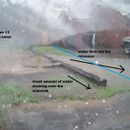
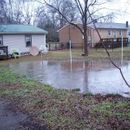
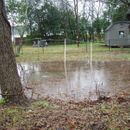
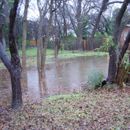
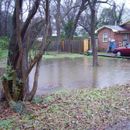







Replies
Try calling your county drain commission and see what they have to say.
DO NOT cut the curb. You need a special permit from your city or county road commission for that.
Your easiest solution is probably a sump pump if you can’t use a berm or similar to direct the water elsewhere. Get a plastic sump pit with a lid. Sometimes you can find purpose-made outdoor drainage basins for this. Set a concrete paver in the bottom of the pit and set a submersible sump pump on the paver. These pumps come with float switches to automatically turn them on and off with water level in the pit.
The sump pump will allow you to use a smaller (usually 1-1/4 or 1-1/2”) pipe to discharge the water, and the pump can push the water up hill to a storm drain. You’ll need to install an electrical circuit into or near the sump pump location, and you should feed this circuit from a GFCI at your house — don’t just use a GFCI receptacle at the sump pit itself.
Bill
Looks like your yard is the low spot. Why can't you just fill your backyard is such a way to divert the water back out to the street?
Tom:
Look at the photo with the white house. That entire area you see with water is not our back yard. Those last four photos begin at the back steps of the house on the corner of the other street. Then on the last photo you see the side of our yard where our red car is parked. If you put all 4 of those last 4 photos side by side you'd get a picture of a very wide area of standing water. It's only recourse is to push to each end as it gets deeper and eventually soaks into the ground. It can't go anywhere else.
Bill:
The city has a storm water department and standing storm water that has no way to drain off "is their specific responsibility" but they say they can't do anything because it's private property and because our street is not maintained by the city though we are inside the city limits. The state department of transportation only handles issues with the sidewalks and street.
With sump pump what allows the electric cable to be protected from the water? Water and electricity are a deadly combination we thought, wrongly it seems. Thanks.
Electricity and water is a bad mix, but it’s entirely possible to build safe electrical things under water. There are subsea power cables to get power to places like Nantucket Island, for example. All perfectly safe IF DONE CORRECTLY.
I prefer to run underground cabling in PVC conduit, with THHN conductors (the individual wires). You can also use UF cable. Either is fine for this application. The usual way to handle the connection to the sump pump would be to either install an outdoor rated receptacle in the sump pit above the water level, or to set a 4x4 post to support an outdoor receptacle above the water level on the ground (usually around 2 feet or so to allow easy access). Either way, the sump pump itself is rated for, and is intended to be, used underwater. The power cord itself is rated for use in water and the plug itself where the sump pump’s power cord plugs in would be installed above the water level.
Using a sump pump to drain standing water automatically is perfectly safe when done correctly and it’s done all the time. Just install everything properly to code in a safe manner and you won’t have any problems.
Bill
From what I can see the water has nowhere to go.
Without a ditch or a sewer to carry away the water there is no ease fix.
You could but in a large dry well to hide the water but a big rain would likely overwhelm it and cost a high percentage of the home’s value.
I think the best answer is to move before the house gets flooded that would require you to disclosure making it unsellable.
Walta
I am digging a 10 foot ditch from the tree nearest the deepest spot. This 20 foot ditch would be perpendicular to the sidewalk. 10 feet on each side of the tree. Maybe 18 inches deep and 12 inches wide creating 30 cubic feet that would hold a bit of water. I'm limited on what I can do since everything you see in the first photo to the left of the blue line is on "their property." I have grounds to file a complaint through the court system but I don't want her to have any reasons to counter sue based on what I'm doing now to help stop the level of the storm water.